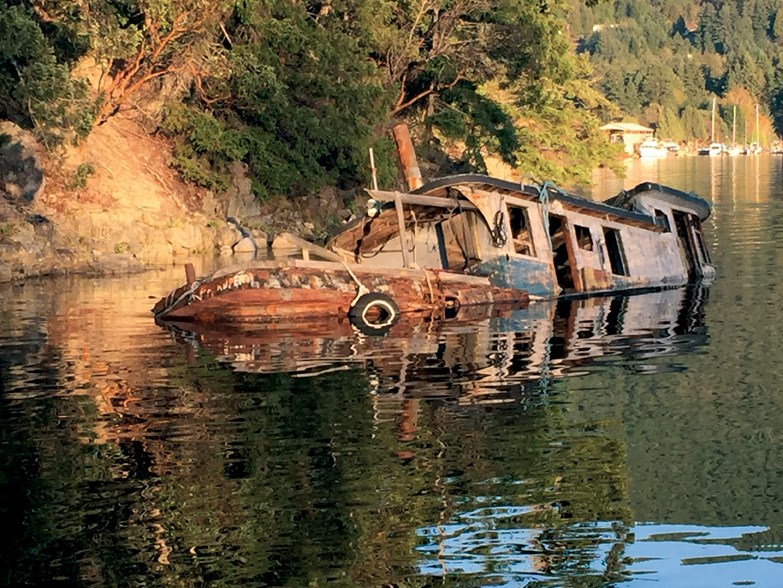A frustrated property owner is trying to get faster action on derelict and abandoned vessels in the Pender Harbour area.
In a letter to the Sunshine Coast Regional District (SCRD), MLA Nicholas Simons, MP Pam Goldsmith-Jones and various government agencies, Brad Clarke raises three specific examples: a live-aboard with no visible registration numbers that’s been anchored for more than two years, an apparently abandoned boat in a navigation channel and a half-sunken tug in Gerrans Bay (Whiskey Slough).
Clarke’s letter was sent just after the federal government announced its Abandoned Vessels Program (see June 9 Coast Reporter), but he points out that only bodies like governments or harbour authorities are eligible to apply for money to deal with problem boats.
“All the local residents in our area are so upset about these derelict, polluting, unsafe vessels and no one will take the lead. I reach out to the three of you to use your influence with various federal and local departments to have these vessels removed and help us clean up Pender Harbour,” Clarke wrote.
Mark Brezer, who operates SloCat Tours in Pender Harbour, said he often hears comments about those same boats from visitors to the area.
“I am on the water in Pender Harbour running boat tours throughout the year, and it doesn’t matter where my guests come from, they are dumbfounded to discover how little governance and accountability there is out there,” Brezer said. “Anyone can drop an anchor almost anywhere they want and just ditch their old boat. Or they can live on it with no questions asked.”
Clarke’s letter also points to the jurisdictional confusion that seems to hamper efforts to deal with abandoned or derelict vessels.
“I am shocked how this issue falls through the cracks of government and no one wants to take responsibility,” he writes. “I have so far contacted Transport Canada, Transport Canada – Receiver of Wrecks, the Coast Guard, DFO and also the RCMP marine unit as well as the Harbour Authority [of Pender Harbour]. I have made at least 12 phone calls to different levels of government and emailed numerous individuals.
“I am delighted that the RCMP have actually started a file on the concerns, but I am sure they are not fully empowered to resolve this issue. Every department and government body tends to point fingers at another department and suggests this is not their issue, but suggests maybe try contacting another federal or local department. This is extremely frustrating and, more to the point, very, very unsafe and bad for the environment, our harbour and every harbour up and down the coast.”
Frank Mauro, the Pender Harbour director for the SCRD and the chair of the local harbour authority, said the problems have gotten worse in the past couple of years, but the harbour authority can only take action on vessels within its lease areas. They do, however, track and report other vessels that may be abandoned or derelict to the appropriate agencies.
Mauro said the harbour authority will look into getting funds through the federal program, but he also noted that some abandoned vessels could be very expensive to get rid of.
“We’ll do what we can and continue to work and make sure we get what we need for the SCRD,” he said, adding that they’ve already had some success working with Transport Canada and RCMP on issuing and enforcing removal orders.
Const. Harrison Mohr of the Sunshine Coast RCMP told Coast Reporter that police will continue their efforts.
“Both last summer and again this year, Sunshine Coast RCMP have been on the waters around the Sunshine Coast checking derelict vessels and working with the vessels’ owners to have them removed,” he said.
“Last year our members had some success in the Pender Harbour area, where a few vessels were removed after the RCMP got involved, and we’re hoping that through continued coordination between local harbour authorities, Sunshine Coast RCMP and vessel owners, we can continue to work to have more of these vessels removed from our waterways.”



